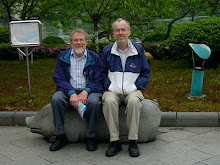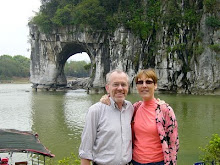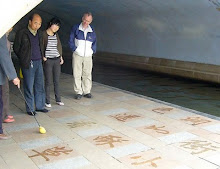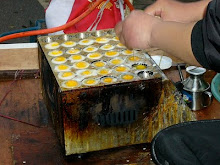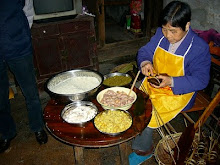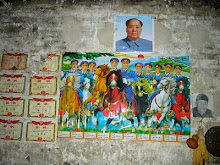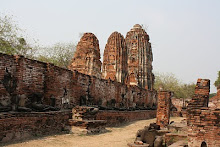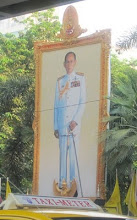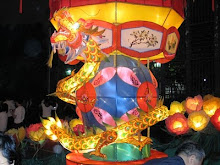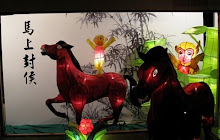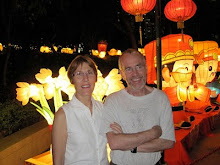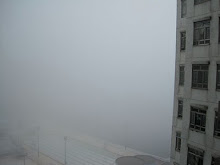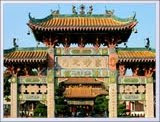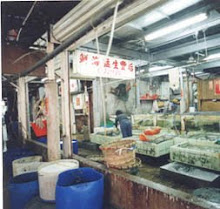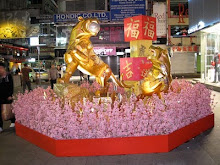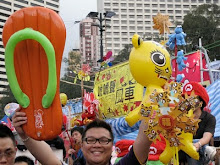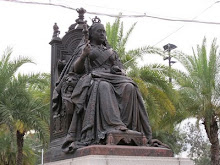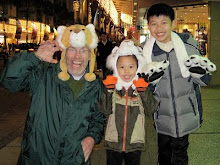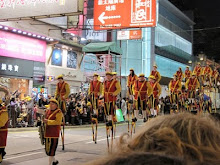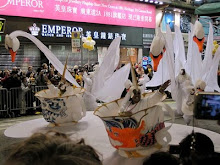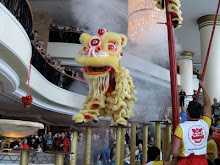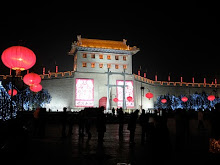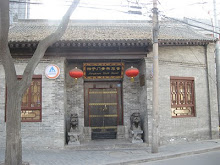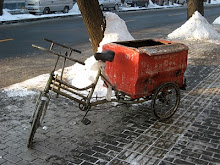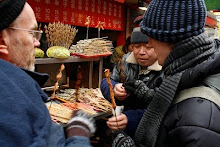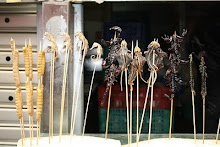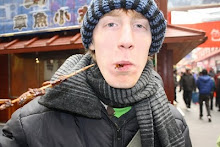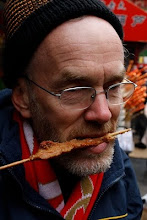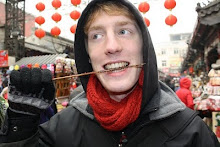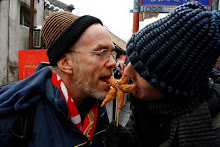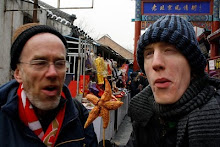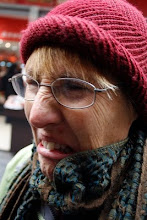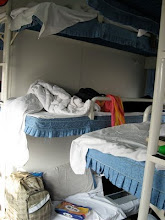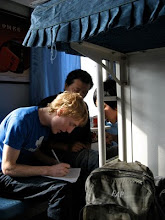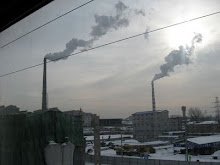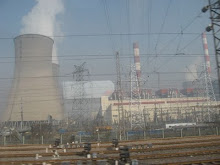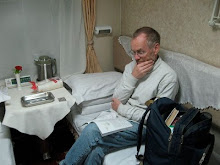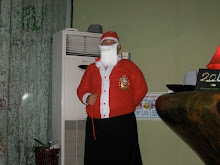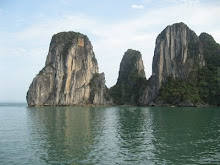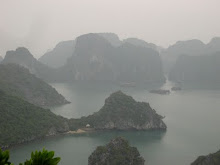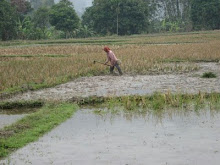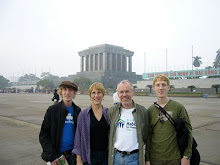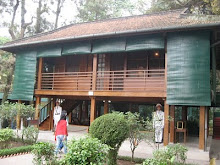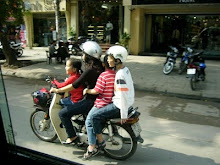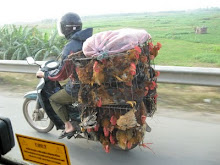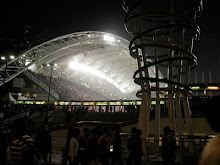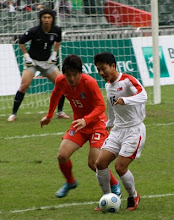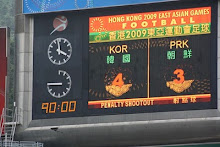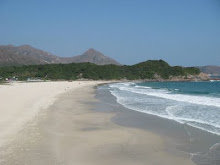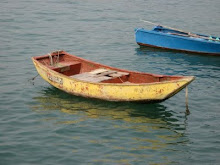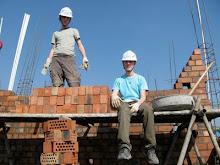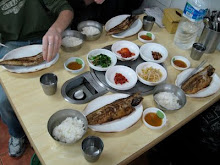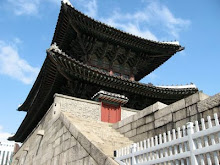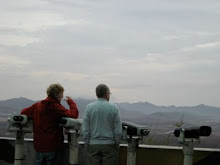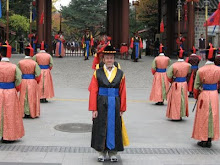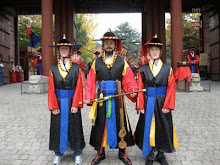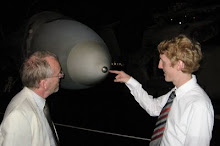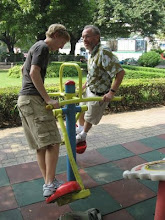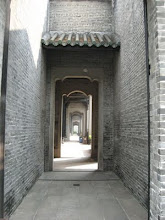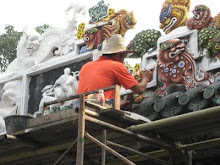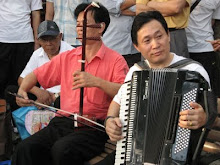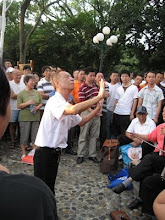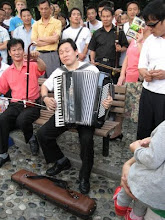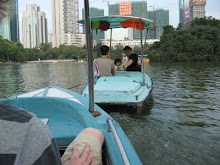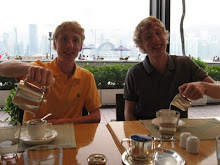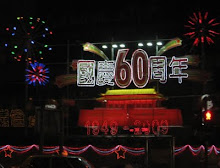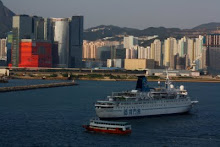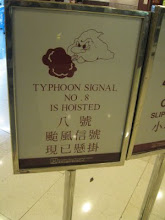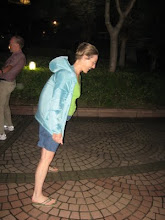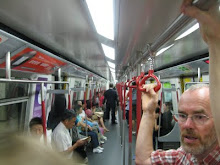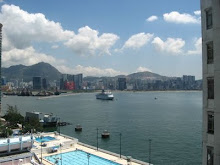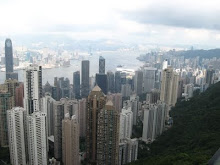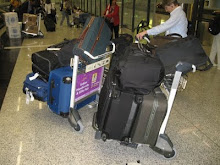On Saturday, I put myself in the hands of my companions, rather than figure everything out myself. Usually, I like to know exactly where I am going and what I am doing, so this was a major departure for me. It started because Elizabeth had gone on line and got tickets for the HK Jockey Club Equine Funfest. The reservations that I felt about attending an event of that name were what caused me to take the take things as they come attitude. HK is very big on horse racing and the Jockey Club makes an enormous amount of money from people's desire to bet on the races. I guess this event was one way in which they give back, although to be fair to them, the Jockey Club gives out money all over the place. So the Equine Funfest was held up at the Shatin racecourse, which actually was where they had the show jumping events for the Beijing Olympics. My favorite adjective to describe the event was remarkable. The most remarkable feature of the Equine Funfest was its lack of horses. There were some nice full sized plastic horses, left over from the Olympics I believe, painted in all sorts of decorative ways. There were ponies on which small children could ride. There were Shetland ponies with which you could be photographed. There were horse-like machines on which you could develop your jockey skills. There was even a mock-up of a horse's rear end on which to practice grooming. But no examples of the real thing. Once we realized that our quest to find real horses was to be in vain, we relaxed and enjoyed the trees.
Actually, the Funfest was the second event of the day because first we went for dim sum, Shanghai style, with Alex and Elaine, two HK friends. Normally we have Cantonese dim sum and that style is relatively plain and simple, allowing the quality of the ingredients to shine through. The Shanghai version was more complex and spicier. A noodle soup with a rich peanut broth, steamed dumplings that magically contained soup in addition to the expected pork. It helped that Alex and Elaine knew what they were going for and could read the menu. It set us up well for the horseless festival.
From Shatin, Alex drove us across the New Territories to Tuen Mun and the Tsing Chung Koon Taoist temple that contained photographs of his godparents. I realize that I do not understand exactly what godparents are in Chinese terms, but honoring ancestors is a very important part of this culture. So having a place where you can go and connect with them is very important. He bought incense sticks on the way in and then both he and Elaine would light a few at a time and present them to the photographs. No actual bodies or ashes were there. They lit some on behalf of themselves and then some for their son, Gary, and then others were presented to the neighboring photos, to keep them happy too. I think there is a sense that of you are good to your ancestors, they will be good to you too. Another important way that people make offerings is to burn stuff, for example bags of fake money. There are stores where you can go and buy all sorts of paper objects - houses, cars, clothes - anything that a person might need in the afterlife. The temple has big ovens to burn these objects, although often you can see people just burning them in the street also.
The temple complex was large, with several buildings including an old peoples' home and a free Chinese medicine clinic. There were nice gardens too, with a pond full of turtles.
We moved on from there to briefly visit the visitor center for the Ping Shan Heritage Trail, a set of walled villages, temples etc., but then we needed to pick up Jacob and Duncan who had spent their day working as English teachers at Mr. Brown's English Highway. We also rendezvoused with Elaine's sister and her husband who also brought Gary. Our two-car convoy then drove off to find the oyster capital of Hong Kong, Lau Fau Shan. We perused the market there thoroughly, and then made our selection of seafood and restaurant. It was a spectacular feast, a large section of an enormous fish that we watched meet its end, cooked two different ways, clams, crabs and then the oysters, either, or I should say both, deep fired in a light batter or sautéed with ginger and garlic. There was a lot more, of course, but these were the memorable bits.
This posting is rather light on photos, I am afraid - J&D were not present for most of it and then E's camera had a battery problem.
Wednesday, February 24, 2010
Thursday, February 18, 2010
February 14 combined Valentine's Day with the first day of the Chinese New Year (CNY). This was viewed as a very auspicious occasion around here, although that might just have been the commercial interests, trying to persuade us of its importance. I did not see much evidence of Valentine's day - there were a few hearts to be found in the street decorations and the fireworks, but there was no missing the Chinese New Year of the Tiger.
Kung Hei Fat Choi is the standard CNY greeting. Best wishes and prosperity. CNY is mostly a family affair, which of course did not involve us. People travel to see their parents and grandparents. The train stations in China got even more crowded as this is one time when you feel that you really have to go. I think this is a few levels beyond the US Thanksgiving obligations. The schools are closed for a week here, although I am expected back at work on Wednesday, so the weekend plus 2 days for me. We followed our normal practice of experiencing everything that we could.
One of the nicest parts is all the flowers. There are lots of flower markets set up several days before hand. One of the biggest is in Victoria Park and so that is where we went. The flowers were gorgeous - lots of gladioli and chrysanthemums and then more specifically Chinese variants - peach and plum blossoms and then small or not so small tangerine (or related citrus) trees. They also have small daffodils that you want to buy closed so that they will open on New Years Day and bring you the most luck. There were many, many flower vendors doing a good trade, but then there were even more stalls selling all manner of junk. HK is the capital of junk and of commercialism and it was out in full force. Tigers made out of everything to fit all parts of your body and to perform all functions. Lots of fair food, some familiar and some not so.
Actually, I have to say, for me CNY food has been something of a disappointment. They have these rice flour cakes, flavored with brown sugar or turnips or carrots. They are extremely gelatinous and not very sweet - in fact sometimes they are savory, with added fish or bacon flavorings. You buy them as circular cakes, slice them, dip them in egg and fry them. Given the numbers of them sold, they must be very popular here, but all I can say is, there is a good reason that most cultures in the world bake with flour made from wheat rather than rice.
Putting aside baking, the Chinese certainly know how to throw a parade. The HK New Year Parade was one of the best I have ever seen. It was certainly the most international. There were fireman gymnasts from France (performing in their fire-fighting gear), flag throwers from Italy, stilt walkers (some ridiculously high) from Belgium, steel drums and puppets from the Notting Hill Carnival, Russian dancers, US cheerleaders (yes, that was a little disappointing) and then, of course participants from all over Asia. Lion dancers and dragon dancers, and dancers of many other kinds, lots of bands, and big commercial floats of varying degrees of creativity. More than 100,000 people come out to watch it so we had to get there early and wait almost 2 hours for the parade to get to us. Actually, it was the first parade that I have ever been to where there was a pre-parade - a Scottish/Hong Kong bagpipe band did a couple of circuits to keep us entertained while waiting.
That was the evening of the first day of the CNY and then the second evening was the fireworks. There have been a few other firework opportunities here, but we have never really seen them at their best. This time we (well at least Jacob and Duncan and I) decided we were going to do whatever it took, so we got ourselves down to the best viewing area, the Avenue of the Stars on the waterfront, about 2.5 hours before they started. We took our first waiting position in a convenient Starbucks (must have one of the best views of all Starbucks). We went and took up position opposite the firework barges with about 1.25 h to go, and the time went pretty fast as we shared stories of our youth. The fireworks were very impressive. They seem to specialize in pictoral displays. So along with the valentine hearts, we had lots of tiger faces, smiley faces, 8s (very lucky) and Chinese characters. We were close enough so we could feel the explosions as well as see and hear them.
We also had a couple of other good close up CNY experiences. Some friends told us that a lion dance company were going to perform in the lobby of a nearby hotel on the morning of CNY Day. They were spectacular - 2 men to a lion, jumping all over the lobby. And then the Notting Hill Carnival group came and performed alongside our Whampoa ship on Tuesday. They were quite foreign in the local context, black-skinned people playing steel drums with great exuberance. Nicely familiar for me, though. And at the end a couple of band members came to greet me because they noticed my Arsenal scarf and wanted to say hi to a fellow supporter.
One other interesting custom is the giving of red packets, small envelopes containing just a little money. Most of the ones I have given contain HK$20 (about 3 US bucks). They go to friends who are younger than you and unmarried and to people that perform services for you, e.g. the security guards and janitors in our apartment complex. The $$ amount is less important than the well wishes and the associated good fortune for the coming year.
Kung Hei Fat Choi is the standard CNY greeting. Best wishes and prosperity. CNY is mostly a family affair, which of course did not involve us. People travel to see their parents and grandparents. The train stations in China got even more crowded as this is one time when you feel that you really have to go. I think this is a few levels beyond the US Thanksgiving obligations. The schools are closed for a week here, although I am expected back at work on Wednesday, so the weekend plus 2 days for me. We followed our normal practice of experiencing everything that we could.
One of the nicest parts is all the flowers. There are lots of flower markets set up several days before hand. One of the biggest is in Victoria Park and so that is where we went. The flowers were gorgeous - lots of gladioli and chrysanthemums and then more specifically Chinese variants - peach and plum blossoms and then small or not so small tangerine (or related citrus) trees. They also have small daffodils that you want to buy closed so that they will open on New Years Day and bring you the most luck. There were many, many flower vendors doing a good trade, but then there were even more stalls selling all manner of junk. HK is the capital of junk and of commercialism and it was out in full force. Tigers made out of everything to fit all parts of your body and to perform all functions. Lots of fair food, some familiar and some not so.
Actually, I have to say, for me CNY food has been something of a disappointment. They have these rice flour cakes, flavored with brown sugar or turnips or carrots. They are extremely gelatinous and not very sweet - in fact sometimes they are savory, with added fish or bacon flavorings. You buy them as circular cakes, slice them, dip them in egg and fry them. Given the numbers of them sold, they must be very popular here, but all I can say is, there is a good reason that most cultures in the world bake with flour made from wheat rather than rice.
Putting aside baking, the Chinese certainly know how to throw a parade. The HK New Year Parade was one of the best I have ever seen. It was certainly the most international. There were fireman gymnasts from France (performing in their fire-fighting gear), flag throwers from Italy, stilt walkers (some ridiculously high) from Belgium, steel drums and puppets from the Notting Hill Carnival, Russian dancers, US cheerleaders (yes, that was a little disappointing) and then, of course participants from all over Asia. Lion dancers and dragon dancers, and dancers of many other kinds, lots of bands, and big commercial floats of varying degrees of creativity. More than 100,000 people come out to watch it so we had to get there early and wait almost 2 hours for the parade to get to us. Actually, it was the first parade that I have ever been to where there was a pre-parade - a Scottish/Hong Kong bagpipe band did a couple of circuits to keep us entertained while waiting.
That was the evening of the first day of the CNY and then the second evening was the fireworks. There have been a few other firework opportunities here, but we have never really seen them at their best. This time we (well at least Jacob and Duncan and I) decided we were going to do whatever it took, so we got ourselves down to the best viewing area, the Avenue of the Stars on the waterfront, about 2.5 hours before they started. We took our first waiting position in a convenient Starbucks (must have one of the best views of all Starbucks). We went and took up position opposite the firework barges with about 1.25 h to go, and the time went pretty fast as we shared stories of our youth. The fireworks were very impressive. They seem to specialize in pictoral displays. So along with the valentine hearts, we had lots of tiger faces, smiley faces, 8s (very lucky) and Chinese characters. We were close enough so we could feel the explosions as well as see and hear them.
We also had a couple of other good close up CNY experiences. Some friends told us that a lion dance company were going to perform in the lobby of a nearby hotel on the morning of CNY Day. They were spectacular - 2 men to a lion, jumping all over the lobby. And then the Notting Hill Carnival group came and performed alongside our Whampoa ship on Tuesday. They were quite foreign in the local context, black-skinned people playing steel drums with great exuberance. Nicely familiar for me, though. And at the end a couple of band members came to greet me because they noticed my Arsenal scarf and wanted to say hi to a fellow supporter.
One other interesting custom is the giving of red packets, small envelopes containing just a little money. Most of the ones I have given contain HK$20 (about 3 US bucks). They go to friends who are younger than you and unmarried and to people that perform services for you, e.g. the security guards and janitors in our apartment complex. The $$ amount is less important than the well wishes and the associated good fortune for the coming year.
Sunday, February 7, 2010
I've written about food and I've written about trains, but those were incidental rather than central to the reasons for going to China. So before I totally forget, let me say a little about what we actually did there. We visited two cities, Xi'an and Beijing. The old capital and the new capital. Both have a lot to recommend them, but Xi'an is a lot easier to deal with as a tourist, I suppose because of its smaller size.
Xi'an is home to the famous terracotta warriors, the army that was buried alongside the first emperor, Qin Shi Huang. He died about 200 BC, so they have been there a while. Apparently, his original plan was to bury the real army alongside himself, but his advisers persuaded him that it would be better to bury full size replicas instead. And replicas they are, each one an individual, with his own features and expression. I think they were known of but not located until about 30 years ago, when a local farmer discovered them while digging a well. It was some kind of anniversary when we there and so said farmer was there at the site, signing guide books. They are impressive, not least because there are so many of them. The largest hall is the size of an aircraft hanger. There are infantrymen, archers, cavalrymen, officers and a few generals, all quite distinguishable from each other. Some of them have been set up in exhibition cases so you can get very close to them. But most are left where they were originally set up, rows upon rows in neat formations. They were painted but the paint faded very soon after they were exposed to air and light. There are many still buried and so they are trying to work out a way of uncovering them and preserving the colors.
There are old parts of Xi'an that are pretty well preserved. It has an intact city wall, of varying ages, that is very impressive. It has spectacular gate towers and a road that runs along the top of it. J, D & E rented bicycles to circumnavigate it - took them about 90 minutes. Also impressive were the Drum Tower and the Bell Tower. Apparently, most old cities in China have them, though usually not on this scale. We stayed in the Xianzimen Youth Hostel, which is located near both towers. It is years since I have stayed in a Youth Hostel and I have never stayed in one as good as Xianzimen. It is located in a complex of old building and we had nicely furnished private rooms. It also has a restaurant and a bar, that appeared well liked by the locals. So it had a very nice feel to it, not least because the people that worked there were very friendly and helpful. If you are ever in Xi'an, check it out.
We went from Xi'an to Beijing on the overnight train. Soft sleepers this time so it was pretty plush. It delivered us to Beijing West Railway Station about 11 AM. There we encountered the longest and one of the slowest moving taxi lines I have encountered. The temperature was about -15 C, so we were well and truly frozen by the time we got to the front of the line. In Beijing we stayed in the Happy Dragon Hostel. Not quite up to the Xianzimen standards, but still pretty good. Elizabeth had a hard time in Beijing because the weather was really cold, apparently the coldest it has been for 30 years. I think it went down to -19 C at night and by the time we left, when it had warmed up a little, it was getting up to about -5 C. There was relatively fresh snow on the ground, although it wasn't added to while we were there. We often came across groups of workers, sometimes soldiers who were removing the snow, shoveling it into trucks or smaller bike powered containers.
I really enjoyed visiting the Great Wall. The weather was cold, but also sunny and not windy. Excellent wall- walking weather, in fact. Very beautiful, with the surrounding mountains covered with snow. We walked along it for a couple of hours, sometimes on the flat, sometimes up or down ancient and uneven stone stairs. Local people, who lived in villages outside the wall, set up little booths and tried to sell us very expensive candy bars or hot drinks. They showed great persistence, greeting each new tourist with enormous enthusiasm.
The Forbidden City seemed almost as big as the Great Wall. It just goes on for ever and ever. Interesting buildings, although most of the artifacts there are not particularly well displayed. One exception is the Clock Museum, which has a wonderful collection, mostly presents to 18th and 19th century emperors.
What else did we do in Beijing? We had to visit the Olympic site, of course. The buildings are spectacular, especially lit up at night. We went to the Peking Opera and a bunch of markets and teahouses and, of course, in addition to the fun food that I already write about, we ate some delicious Peking duck.
Xi'an is home to the famous terracotta warriors, the army that was buried alongside the first emperor, Qin Shi Huang. He died about 200 BC, so they have been there a while. Apparently, his original plan was to bury the real army alongside himself, but his advisers persuaded him that it would be better to bury full size replicas instead. And replicas they are, each one an individual, with his own features and expression. I think they were known of but not located until about 30 years ago, when a local farmer discovered them while digging a well. It was some kind of anniversary when we there and so said farmer was there at the site, signing guide books. They are impressive, not least because there are so many of them. The largest hall is the size of an aircraft hanger. There are infantrymen, archers, cavalrymen, officers and a few generals, all quite distinguishable from each other. Some of them have been set up in exhibition cases so you can get very close to them. But most are left where they were originally set up, rows upon rows in neat formations. They were painted but the paint faded very soon after they were exposed to air and light. There are many still buried and so they are trying to work out a way of uncovering them and preserving the colors.
There are old parts of Xi'an that are pretty well preserved. It has an intact city wall, of varying ages, that is very impressive. It has spectacular gate towers and a road that runs along the top of it. J, D & E rented bicycles to circumnavigate it - took them about 90 minutes. Also impressive were the Drum Tower and the Bell Tower. Apparently, most old cities in China have them, though usually not on this scale. We stayed in the Xianzimen Youth Hostel, which is located near both towers. It is years since I have stayed in a Youth Hostel and I have never stayed in one as good as Xianzimen. It is located in a complex of old building and we had nicely furnished private rooms. It also has a restaurant and a bar, that appeared well liked by the locals. So it had a very nice feel to it, not least because the people that worked there were very friendly and helpful. If you are ever in Xi'an, check it out.
We went from Xi'an to Beijing on the overnight train. Soft sleepers this time so it was pretty plush. It delivered us to Beijing West Railway Station about 11 AM. There we encountered the longest and one of the slowest moving taxi lines I have encountered. The temperature was about -15 C, so we were well and truly frozen by the time we got to the front of the line. In Beijing we stayed in the Happy Dragon Hostel. Not quite up to the Xianzimen standards, but still pretty good. Elizabeth had a hard time in Beijing because the weather was really cold, apparently the coldest it has been for 30 years. I think it went down to -19 C at night and by the time we left, when it had warmed up a little, it was getting up to about -5 C. There was relatively fresh snow on the ground, although it wasn't added to while we were there. We often came across groups of workers, sometimes soldiers who were removing the snow, shoveling it into trucks or smaller bike powered containers.
I really enjoyed visiting the Great Wall. The weather was cold, but also sunny and not windy. Excellent wall- walking weather, in fact. Very beautiful, with the surrounding mountains covered with snow. We walked along it for a couple of hours, sometimes on the flat, sometimes up or down ancient and uneven stone stairs. Local people, who lived in villages outside the wall, set up little booths and tried to sell us very expensive candy bars or hot drinks. They showed great persistence, greeting each new tourist with enormous enthusiasm.
The Forbidden City seemed almost as big as the Great Wall. It just goes on for ever and ever. Interesting buildings, although most of the artifacts there are not particularly well displayed. One exception is the Clock Museum, which has a wonderful collection, mostly presents to 18th and 19th century emperors.
What else did we do in Beijing? We had to visit the Olympic site, of course. The buildings are spectacular, especially lit up at night. We went to the Peking Opera and a bunch of markets and teahouses and, of course, in addition to the fun food that I already write about, we ate some delicious Peking duck.
Subscribe to:
Posts (Atom)

